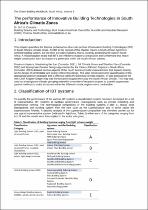 ResearchSpace
ResearchSpace
The performance of innovative building technologies in South Africa’s climatic zones
JavaScript is disabled for your browser. Some features of this site may not work without it.
- ResearchSpace
- →
- Research Publications/Outputs
- →
- Book Chapters
- →
- View Item
| dc.contributor.author |
Conradie, Dirk CU

|
|
| dc.date.accessioned | 2014-08-15T13:13:02Z | |
| dc.date.available | 2014-08-15T13:13:02Z | |
| dc.date.issued | 2014-03 | |
| dc.identifier.citation | Conradie, D.C.U. 2014. The performance of innovative building technologies in South Africa’s climatic zones. In: Green Building Handbook, South Africa: Volume 6: The Essential Guide. Alive2green publishing: Cape Town, South Africa, pp 165-188 | en_US |
| dc.identifier.isbn | 9780620452403 | |
| dc.identifier.uri | http://www.alive2green.com/greenbuilding/handbook/volume6/files/assets/basic-html/page168.html | |
| dc.identifier.uri | http://hdl.handle.net/10204/7606 | |
| dc.description | Green Building Handbook, South Africa: Volume 6: The Essential Guide | en_US |
| dc.description.abstract | This chapter quantifies the thermal performance of a cross section of Innovative Building Technologies (IBT) in South Africa's climatic zones. An IBT in the context of this chapter means a South African Agrément certified building system, but the term excludes masonry, that is currently predominantly used in South Africa. A misconception exists that IBT¿s are inferior to masonry construction and furthermore that heavy weight construction such as masonry is preferable within the South African context. Previous chapters, Maximising the Sun (Conradie, 2011), SA Climate Zones and Weather Files (Conradie, 2012) and Appropriate Passive Design Approaches for the Various Climatic Regions in South Africa (Conradie, 2013) detailed various aspects of the South African climatic characteristics that impacts directly on the design of comfortable and energy efficient buildings. The latter introduced some quantification of the appropriate passive strategies that is effective within the particular climatic regions. In said publications the new CSIR Köppen-Geiger map was introduced to support the study the South African climate. This map was used as a background climatic grouping method in a number of research projects to quantify appropriate passive methods to make structures within the different climatic regions more comfortable. | en_US |
| dc.language.iso | en | en_US |
| dc.publisher | Alive2green | en_US |
| dc.relation.ispartofseries | Workflow;13205 | |
| dc.subject | Thermal performance | en_US |
| dc.subject | Innovative building technologies | en_US |
| dc.subject | IBT | en_US |
| dc.subject | South African climate zones | en_US |
| dc.title | The performance of innovative building technologies in South Africa’s climatic zones | en_US |
| dc.type | Book Chapter | en_US |
| dc.identifier.apacitation | Conradie, D. C. (2014). The performance of innovative building technologies in South Africa’s climatic zones., <i>Workflow;13205</i> Alive2green. http://hdl.handle.net/10204/7606 | en_ZA |
| dc.identifier.chicagocitation | Conradie, Dirk CU. "The performance of innovative building technologies in South Africa’s climatic zones" In <i>WORKFLOW;13205</i>, n.p.: Alive2green. 2014. http://hdl.handle.net/10204/7606. | en_ZA |
| dc.identifier.vancouvercitation | Conradie DC. The performance of innovative building technologies in South Africa’s climatic zones.. Workflow;13205. [place unknown]: Alive2green; 2014. [cited yyyy month dd]. http://hdl.handle.net/10204/7606. | en_ZA |
| dc.identifier.ris | TY - Book Chapter AU - Conradie, Dirk CU AB - This chapter quantifies the thermal performance of a cross section of Innovative Building Technologies (IBT) in South Africa's climatic zones. An IBT in the context of this chapter means a South African Agrément certified building system, but the term excludes masonry, that is currently predominantly used in South Africa. A misconception exists that IBT¿s are inferior to masonry construction and furthermore that heavy weight construction such as masonry is preferable within the South African context. Previous chapters, Maximising the Sun (Conradie, 2011), SA Climate Zones and Weather Files (Conradie, 2012) and Appropriate Passive Design Approaches for the Various Climatic Regions in South Africa (Conradie, 2013) detailed various aspects of the South African climatic characteristics that impacts directly on the design of comfortable and energy efficient buildings. The latter introduced some quantification of the appropriate passive strategies that is effective within the particular climatic regions. In said publications the new CSIR Köppen-Geiger map was introduced to support the study the South African climate. This map was used as a background climatic grouping method in a number of research projects to quantify appropriate passive methods to make structures within the different climatic regions more comfortable. DA - 2014-03 DB - ResearchSpace DP - CSIR KW - Thermal performance KW - Innovative building technologies KW - IBT KW - South African climate zones LK - https://researchspace.csir.co.za PY - 2014 SM - 9780620452403 T1 - The performance of innovative building technologies in South Africa’s climatic zones TI - The performance of innovative building technologies in South Africa’s climatic zones UR - http://hdl.handle.net/10204/7606 ER - | en_ZA |





